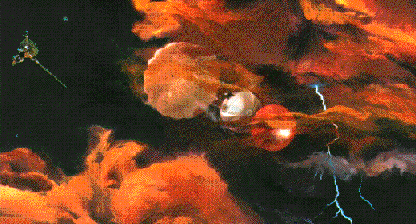

Galileo Project Information
Launch Date: 18 October 1989 at 22:23 UTC
Launch Vehicle: Shuttle/Inertial Upper Stage
On-orbit mass: 2380 Kg
Power System: Radioisotope Thermal Generators (RTGs) of 570 W
Release Date: 13 July 1995 at 05:30 UTC
Entry Date: 07 December 1995 at 22:04 UTC (5:04 p.m. EST)
Launch Vehicle: Shuttle/Inertial Upper Stage
On-orbit mass: 335 Kg
Power System: Storage batteries of 580 W
The Galileo mission consists of two spacecraft: an orbiter and an atmospheric probe. Launched during the STS 34 flight of the Atlantis orbiter, the two spacecraft were kicked out of Earth orbit by an inertial upper stage (IUS) rocket, sending them careening through the inner solar system. The trajectory which the spacecraft followed was called a VEEGA (Venus-Earth-Earth Gravity Assist), traveling first in toward the Sun for a gravity assist from Venus before encountering the Earth two times (spaced two years apart). These encounters with Venus and the Earth allowed Galileo to gain enough velocity to get it out to Jupiter.
During the flybys of Venus and the Earth, Galileo scientists took the opportunity to study these two planets as well as the Moon, making some unprecedented observations as a result. In addition, following each Earth flyby, Galileo made excursions as far out in the solar system as the asteroid belt, enabling scientists to make the first close-up studies of two asteroids, Gaspra and Ida. As is this were not sufficient, Galileo scientists were fortunate to be the only ones with a direct view of the Comet Shoemaker-Levy 9 fragment impacts on Jupiter. All of this was prior to the primary missions of sending an atmospheric probe into Jupiter's atmosphere and studying Jupiter, its satellites, and its magnetosphere for two years with the orbiter.
Interplanetary studies were also made sporadically by some of the other Galileo instruments, including the dust detector, magnetometer, and various plasma and particles detectors, during its six year journey to Jupiter.
The probe was released from the orbiter 147 days prior to its entry into the Jovian atmosphere on 7 December 1995.
The science goals of the Galileo Probe were to:
The objectives of the Galileo Orbiter are to:
Although Galileo was not the first mission to explore Jupiter (actually, it is the sixth), it has established a number of "firsts" during its journey.
A comprehensive list of the science results of Galileo would be longer than space permits. Here, then, is a short list of some important discoveries (in no particular order).
Information about the Galileo Orbiter
Information about Galileo Orbiter experiments
Information about Galileo Orbiter data
Information about the Galileo Probe
Information about Galileo Probe experiments
Information about STS 34 (Galileo deployment mission)
Galileo probe timeline of events
Galileo orbiter event information
Index of images taken by Galileo
in the NSSDCA Photo Gallery
Galileo Images of Callisto
Galileo Images of Ganymede
Galileo Images of Europa
Galileo Images of Io
Order the Galileo imaging CD-ROM set
Surprising early science results
from the Galileo probe
More science results from the
Galileo probe
Science results from the first
Io flyby!
Science results from the first
Ganymede flyby!
Possible discovery of liquid water
on Europa
Possible discovery of ionosphere
on Io
More about water on Europa
Wet and dry spots on Jupiter
Discovery of ionosphere
on Europa
Galileo's tape recorder problem
(NASA press release, 10/12/95)
Galileo's fixed tape recorder
(NASA press release, 10/21/95)
More about Galileo's tape recorder
(NASA press release, 10/26/95)
Galileo and the Comet
Shoemaker-Levy 9 impact on Jupiter
Galileo lunar data
Obtain Galileo position data (heliographic coordinates)
Solid State Imaging (SSI) (NASA JPL)
Magnetometer (MAG) (UCLA)
Ultraviolet/Extreme Ultraviolet Spectrometer
(UVS/EUVS) (U. Colorado)
Dust Detector (DDS) (MPI) Data
Heavy Ion Counter (HIC) (Cal. Tech.)
Near Infrared Mapping Spectrometer (NIMS) (UCLA)
Neutral Mass Spectrometer (NMS)
Plasma Wave (PWS) (U. Iowa)
Plasma Particle (PLS) (U. Iowa)
PLS and PWS (U. Iowa)
Data
Energetic Particles Detector (EPD) (JHU/APL)
Energetic Particles Detector (EPD) (U. Kansas)
Data
Online from Jupiter (K-12 student/teacher information/activities)
